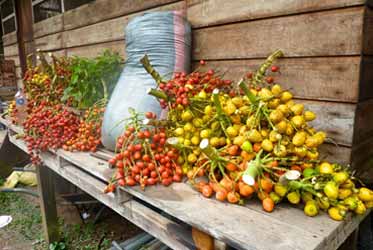Wood vs. Chonta
In the Peruvian Amazon, many jungle dwellers are reluctant to call palms ‘trees’. They are a category of plants unto themselves. And as would logically follow, the timber of palms is not called wood. Trees provide wood. Palms provide chonta. Many species of palms provide useful timbers. Pona (Iriartea deltoidea and Dictyocaryum lamarckianum) trunks are split open longitudinally to form mats used as flooring. The slats of huasaí (Euterpe precatoria, the Peruvian version of the more famous Brazilian açaí) are a durable material for walls. Sturdy posts made from the impressive aerial roots and trunk of the walking palm (Cashapona or Socratea exorrhiza) were once a favorite building material among natives and rubber tappers in the Brazilian state of Acre. Palm timbers are ever-available, quick to prepare for use, with a remarkable ease for longitudinal splitting and extraordinary strength perpendicular to the grain.
Drawing parallels, the palm equivalent to wood’s grain is the chonta’s fiber. Palms can be likened to bundles of vertical cords running the length of the trunk, hence the ease in splitting lengthwise, and the difficulty in breaking across the grain. No Amazonian palm possesses quite the same kind of density and toughness as the species known to botanists as Bactris gasipaes – or pijuayo, as the peach palm is known throughout Peru. Bows, arrows, and spears are all fashioned from the shiny black chonta of this species, as are the ceremonial staffs of the ch’unchus, those dancing descendants of the Inkas at Qoyllorit’i.
The walking palm, Socratea exorrhiza, extends new roots in the direction of greater access to sun. Older roots eventually die back, and in the process the palm is indeed able to walk across the forest floor. Photo thanks to Joyce George, taken at Camino Verde’s reforestation center.
The strength of chonta de pijuayo is the stuff of legend. These tall-growing palms are thought to ‘pull’ lightning, and the charred, still standing remains of many tall peach palms confirm this observation. Its usefulness for basic tools and weapons made this species an obvious candidate for early domestication, and in fact it is thought to be one of the first trees bred by humans in the Americas. Yet it was not only for the amazing chonta that pijuayo caught the interest of ancient Amazonians. In a forest of abundant providers, palms are outstanding in their production of extraordinary quantities of fruit. A tree of many gifts, pijuayo was also planted early on for its value as an important edible staple crop.
The Apple of the Amazon
Pijuayo’s English name, peach palm, is misleading for several reasons. First, the peach palm is unlike a peach in that its starchy, oily fruits are not soft, perfumey, or sweet – and are boiled before consumption. Second, the size and shape of peach palm fruits varies greatly but rarely resembles the shape or size of a peach. From grape-sized, high oil content wild varieties to large, potato-sized starchy fruits slightly cone-like in shape, variability of the fruit is one of the hallmarks of pijuayo.
Variability for example in colors. Red and yellow are the main varieties. Then less commonly orange, and even red with white striations striping the fruit and called “Peruvian flag.”
“Giddily tall and straight, have up to a dozen stalks, with a protective mat of spikes wrapped around the bottom of the tree. The protection is little needed; peach palm wood is hard enough that in Beni it was used for sawblades. Bundles of orange or red fruit hang like clusters of bocce balls from the base of the fronds. The fruit is soaked with oil and rich in beta-carotene, vitamin C, and, surprisingly, protein… In terms of yield per acre, peach palms are typically much more productive than rice, beans, or maize. Trees begin producing fruit after three to five years and can continue for another seventy years… Bactris gasipaes, as scientists call it, has more than two hundred common names: pupunha, cahipay, tembe, pejibaye, chontaduro, pijuayo… The proliferation of names suggests the plant was used for many purposes by many cultures.”
~ Charles Mann, 1491
Pijuayo fruits come in various shapes, sizes, and colors. This is a typical weekly harvest at Camino Verde’s reforestation center in Tambopata, Peru. Photo by Robin Van Loon
What’s eaten is the pulp of the fruit, in between the bright-colored peel that’s removed and a hard pit. The pulp of yellow fruits is usually a pale, potato-like color. Red fruits can have egg-yolk yellow or bright red-orange flesh. This pulp is eaten as fruit in hand, sometimes with salt or hot pepper concoctions; it tastes like corn on the cob, a potato, or squash, and has an oily taste reminiscent of unrefined red palm oil. In the other most common form on consumption, the pulp is mashed up and made into a thick, mildly fermented beverage called chicha or masato de pijuayo, which often has sugar added and a sour tang. While not traditional, the peeled, pitted fruits can also be used effectively in soup not unlike cream of squash or in salads and stir fries.
In all the various sizes and colors of fruit, the seed or pit within the fruit is roughly the same size and has certain peculiarities to it. First, it’s edible. You have to crunch through a hard outer layer, but inside the seed is a sweet, milky kernel that’s delicious, similar a tiny coconut. It’s another source of food apart from the fruit pulp.
The second curious thing about the seed is that it looks like a tiny skull. There are two small dimples spaced like eye sockets in the pit’s shell. The similarity gives rise to mythic stories about how the first pijuayo grew from where the skull of an enchanted young man was buried. It shouldn’t surprise us that there are colorful stories about this tree. It was after all clearly one of the most important domesticated crops in the impressive agricultural heritage of the Amazon. And indigenous cultures perceive special value in their staple crops, as at Chavin de Hauntar.
Some modern tribes continue to observe taboos that perhaps were widely held among the millions of Amazonians alive in 1492. For example, there are taboos that prohibit the hunting of macaws in the time of fruiting of pijuayo. Macaws nest and mate during this season, and macaws can be pests pecking at the unripe fruits. As such, perhaps the prohibition was a needed one to keep the ecologically significant macaw populations robust.
These are trees that feed many. In addition to the parrots, monkeys and other tree-dwelling mammals nab fruits right from the trunk. Fallen fruits are food for many species of rodents and peccaries, the wild pigs of the Neotropics.
Like many palms, pijuayo is an extraordinary producer. Fruits are clustered on bracts called racemes, bundles of rope-like strands dangled heavy, as each raceme carries dozens of fruits. A single trunk of pijuayo can hold up to sixteen racemes. And this is a clumping palm, meaning that it is possible to have as many as four producing stalks to a clump. When pijuayo is in season, this productivity is noticed by the forest – and utilized. Mega-abundant fruiting was surely one of the reasons pijuayo was selected as an early species for domestication. People, like other animals, came to rely on pijuayo as an important food source.
But the fruit and its seeds aren’t the only sources of food from this remarkable plant. Its growth bud is also a sort of cabbage.
A single trunk of pijuayo can give as many as 16 racemes. Some plants of pijuayo have four stalks and can produce over 30 racemes in a good year. Photo by Robin Van Loon
A Palm’s Heart
Many non-tropical people have trouble imagining what part of the plant exactly is the so-called heart of palm, best known to many as the protagonist of brine-filled cans or jars. Some erroneously imagine a column of soft flesh running up the interior of the entire trunk of the palm. In reality, the heart of palm or palm cabbage – most commonly called chonta or palmito in Peru – comes from the growth bud of the palm, the place where new leaves emerge at the top of the trunk.
In the area between where the uppermost “neck” of the hard trunk of a palm ends – and below where its leaves shoot out to the sides – is a green-sheathed cylinder from which new leaves and racemes of flowers and fruits emerge. This green cylinder just so happens to be the largest growth bud of any plant in the world.
To be clear, the top ranking is applied to the growth buds of palms and not to the species, peach palm, in particular. Worthy of note is that almost all Amazonian palms have edible palmito, though taboo and ease of harvest are strong determinants in deciding which species are utilized and which are spared. Because of the wide scale of cultivation, much of the heart of palm on the market comes from those clumping palms whose fruits are economically signficant.
B. gasipaes (peach palm) and Euterpe oleracea (açaí) are probably the most important species in the Latin American heart of palm industry. At present, something similar unfortunately cannot be said for peach palm’s delicious, oily seeds.
About the Author
Founder and Executive Director of Camino Verde, Robin has lived in the Tambopata province of the Peruvian Amazon since 2004. A long-time student of traditional and indigenous agriculture and medicinal practices, his work has focused on developing community-based reforestation strategies to regenerate important endangered plants of the Amazon. He is a writer, regenerative designer, and consultant in agroforestry, reforestation, and regenerative development.




